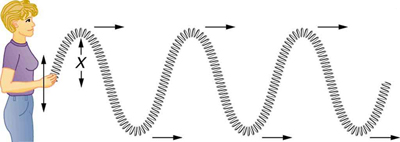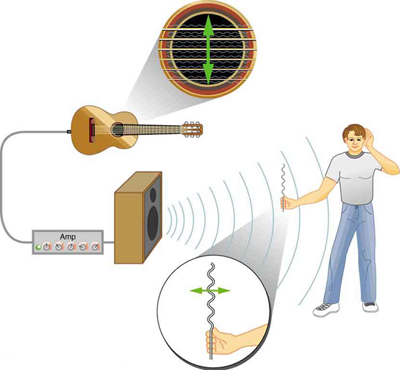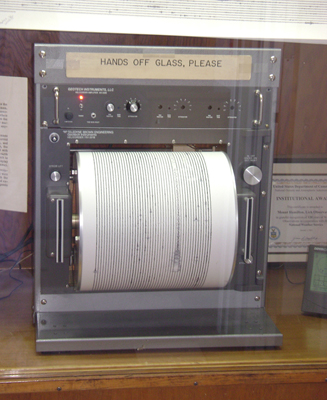Oscillatory Motion and Waves and Physics of Hearing.
124 Waves
Learning Objectives
- State the characteristics of a wave.
- Calculate the velocity of wave propagation.

What is a wave? The most intuitive example is a water wave—a disturbance that propagates through a medium, moving from the place it was created. In water waves, this disturbance affects the water’s surface, possibly caused by a splash or a falling object. In sound waves, the disturbance involves pressure variations in air. In earthquakes, disturbances travel through Earth’s crust and interior. Even electromagnetic wavessuch as radio waves behave with similar principles. Across all types of waves, key characteristics like amplitude, frequency, and energy follow a unified set of physical rules.
Waves that repeat regularly are associated with simple harmonic motion. Consider the stylized wave shown in Figure 124.2. It creates an up-and-down disturbance in the water, which causes a sea gull to bob in harmonic motion as crests and troughs pass beneath it. The time for one full up-and-down motion is the wave’s period [latex]T[/latex], and the frequency is given by:
Although the disturbance moves to the right in the figure, the water itself does not move laterally—the gull remains in place vertically. This is because the energy moves, not the medium. The wave velocity [latex]v_{\text{w}}[/latex] describes the speed at which the disturbance propagates through the medium, and is sometimes called the propagation velocity.

The wavelength [latex]\lambda[/latex] is the distance between two corresponding points on successive cycles of the wave—usually between adjacent crests or troughs. Since one full wavelength travels in the time of one period, the wave speed is given by:
Using the relationship [latex]f = \frac{1}{T}[/latex], we can also express wave speed as:
This relationship holds for all waves: surface waves on water, sound waves in air, or light waves in a vacuum. The wave speed [latex]v_{\text{w}}[/latex] depends on the medium and type of wave.
Misconception Alert
Many people think waves transport the medium itself (like water in the ocean), but that’s not true. The particles of the medium typically oscillate in place while the energy of the wave moves forward. So if you feel “pushed” by a wave in the ocean, you’re feeling the force due to wave energy—not the bulk motion of water.
Take-Home Experiment: Waves in a Bowl
Fill a large bowl with still water. Drop a cork gently into the center and observe the waves that form. Estimate the wavelength and period of the ripples. Try again by dropping the cork from a different height. Does the height of the drop affect the wavelength? What stays the same and what changes?
Example 124.1: Calculate the Velocity of Wave Propagation: Gull in the Ocean
Calculate the wave velocity of the ocean wave in Figure 124.2 if the distance between wave crests is 10.0 m and the time for a sea gull to bob up and down is 5.00 s.
Strategy
We are asked to find [latex]{v}_{\text{w}}[/latex]. The given information tells us that [latex]\lambda =\text{10}\text{.}0\phantom{\rule{0.25em}{0ex}}\text{m}[/latex] and [latex]T=5\text{.}\text{00}\phantom{\rule{0.25em}{0ex}}\text{s}[/latex]. Therefore, we can use [latex]{v}_{\text{w}}=\frac{\lambda }{T}[/latex] to find the wave velocity.
Solution
- Enter the known values into [latex]{v}_{\text{w}}=\frac{\lambda }{T}[/latex]:
[latex]{v}_{\text{w}}=\frac{\text{10.0 m}}{5\text{.00 s}}.[/latex]
- Solve for [latex]{v}_{\text{w}}[/latex] to find [latex]{v}_{\text{w}}\text{= 2.00 m/s.}[/latex]
Discussion
This slow speed seems reasonable for an ocean wave. Note that the wave moves to the right in the figure at this speed, not the varying speed at which the sea gull moves up and down.
Transverse and Longitudinal Waves
A wave is a periodic disturbance that travels through space or a medium. In a transverse wave, like the one shown in Figure 124.3, the disturbance occurs perpendicular to the direction the wave propagates. These are often called shear waves. In contrast, a longitudinal wave involves a disturbance that is parallel to the direction of propagation, as illustrated in Figure 124.4. The amplitude of a wave, represented as X, describes the size of the disturbance and is independent of the wave’s propagation speed [latex]{v}_{\text{w}}[/latex].


Some waves combine both transverse and longitudinal components. For instance, water waves exhibit both types of motion. In the simplified model of a water wave shown in Figure 124.5, only the up-and-down (transverse) motion is visible, but real water waves involve circular particle motion due to both longitudinal and transverse effects.
The type of wave depends on the medium. The vibrating strings of musical instruments produce transverse waves. Electromagnetic waves, such as visible light and radio waves, are also transverse. Sound waves in fluids (like air or water) are longitudinal, since fluids lack the structural rigidity required to support transverse shear waves. In solids, however, both longitudinal and transverse sound waves can exist.

Seismic waves from earthquakes are another example. Beneath Earth’s surface, both longitudinal (P-waves) and transverse (S-waves) travel through rock. These wave types differ in speed and behavior. Earthquakes also produce surface waves similar to water waves, which can be particularly damaging.
Check Your Understanding
Why is it important to differentiate between longitudinal and transverse waves?
Different wave types transfer energy differently through materials. Understanding whether the disturbance is parallel or perpendicular to the direction of motion helps us predict how energy will affect the surrounding medium.
PhET Explorations: Wave on a String
Use this interactive simulation to create and observe waves on a string. You can vary frequency, amplitude, tension, and damping, and choose whether the end is fixed, loose, or open.
Section Summary
- A wave is a disturbance that propagates through a medium with velocity [latex]{v}_{\text{w}}[/latex].
- Wavelength [latex]\lambda[/latex] is the distance between successive identical parts of the wave.
- The relationship between wave speed, frequency, and wavelength is [latex]{v}_{\text{w}}=\frac{\lambda}{T}[/latex] or [latex]{v}_{\text{w}}=f\lambda[/latex].
- In transverse waves, the disturbance is perpendicular to wave propagation. In longitudinal waves, it is parallel.
Conceptual Questions
- Give one example of a transverse wave and another of a longitudinal wave, being careful to note the relative directions of the disturbance and wave propagation in each.
- What is the difference between propagation speed and the frequency of a wave? Does one or both affect wavelength? If so, how?
Problems & Exercises
- Storms in the South Pacific can create waves that travel all the way to the California coast, which are 12,000 km away. How long does it take them if they travel at 15.0 m/s?
- Waves on a swimming pool propagate at 0.750 m/s. You splash the water at one end of the pool and observe the wave go to the opposite end, reflect, and return in 30.0 s. How far away is the other end of the pool?
- Wind gusts create ripples on the ocean that have a wavelength of 5.00 cm and propagate at 2.00 m/s. What is their frequency?
- How many times a minute does a boat bob up and down on ocean waves that have a wavelength of 40.0 m and a propagation speed of 5.00 m/s?
- Scouts at a camp shake the rope bridge they have just crossed and observe the wave crests to be 8.00 m apart. If they shake it the bridge twice per second, what is the propagation speed of the waves?
- What is the wavelength of the waves you create in a swimming pool if you splash your hand at a rate of 2.00 Hz and the waves propagate at 0.800 m/s?
- What is the wavelength of an earthquake that shakes you with a frequency of 10.0 Hz and gets to another city 84.0 km away in 12.0 s?
- Radio waves transmitted through space at [latex]3\text{.}\text{00}×{\text{10}}^{8}\phantom{\rule{0.25em}{0ex}}\text{m/s}[/latex] by the Voyager spacecraft have a wavelength of 0.120 m. What is their frequency?
- Your ear is capable of differentiating sounds that arrive at the ear just 1.00 ms apart. What is the minimum distance between two speakers that produce sounds that arrive at noticeably different times on a day when the speed of sound is 340 m/s?
- (a) Seismographs measure the arrival times of earthquakes with a precision of 0.100 s. To get the distance to the epicenter of the quake, they compare the arrival times of S- and P-waves, which travel at different speeds. Figure 124.7) If S- and P-waves travel at 4.00 and 7.20 km/s, respectively, in the region considered, how precisely can the distance to the source of the earthquake be determined? (b) Seismic waves from underground detonations of nuclear bombs can be used to locate the test site and detect violations of test bans. Discuss whether your answer to (a) implies a serious limit to such detection. (Note also that the uncertainty is greater if there is an uncertainty in the propagation speeds of the S- and P-waves.)

Glossary
- longitudinal wave
- a wave in which the disturbance is parallel to the direction of propagation
- transverse wave
- a wave in which the disturbance is perpendicular to the direction of propagation
- wave velocity
- the speed at which the disturbance moves. Also called the propagation velocity or propagation speed
- wavelength
- the distance between adjacent identical parts of a wave
a disturbance that moves from its source and carries energy
the speed at which the disturbance moves. Also called the propagation velocity or propagation speed
the distance between adjacent identical parts of a wave
a wave in which the disturbance is parallel to the direction of propagation
a wave in which the disturbance is perpendicular to the direction of propagation

